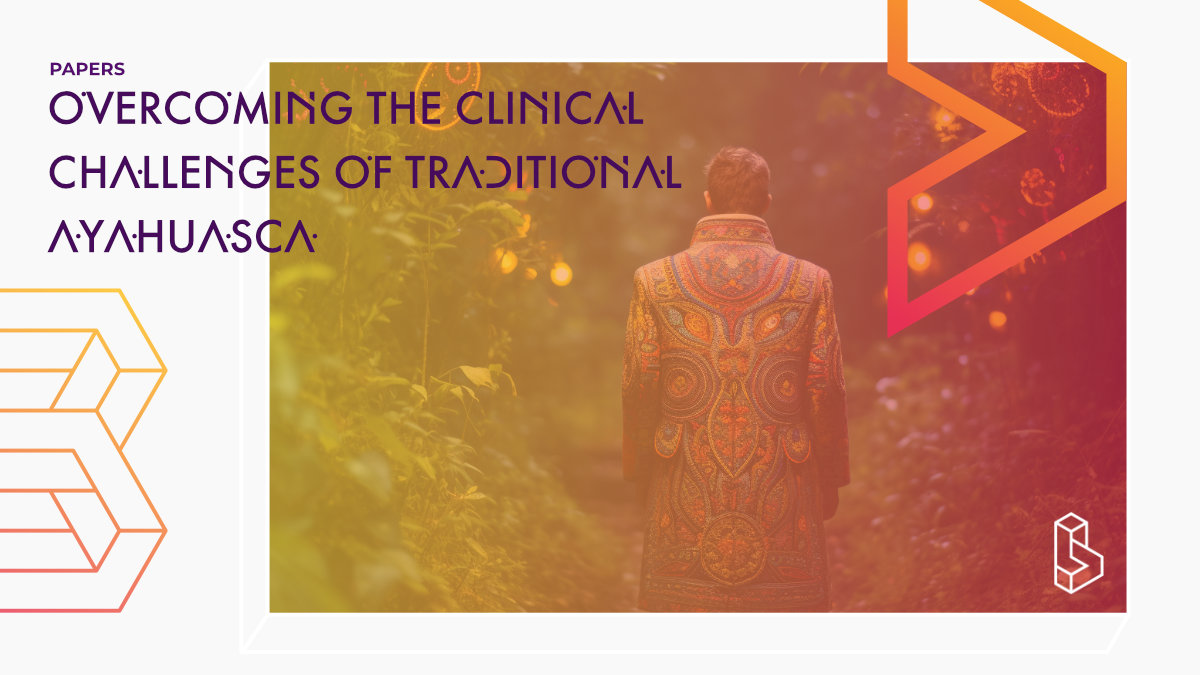This open-label within-subject study (n=10) compared the oral administration of a capsule (containing DMT and harmine) with combined intranasal administration of an oromucosal harmine tablet and an intranasal DMT spray at two doses. The research aimed to improve the pharmacokinetics and tolerability profiles of ayahuasca-analogue formulations. Results indicate that the combined buccal/intranasal administration substantially attenuated common side effects and yielded significantly improved pharmacokinetic profiles. This suggests it may be an innovative approach for the safe and patient-oriented administration of DMT/harmine for treating affective disorders.
Abstract of Overcoming the clinical challenges of traditional ayahuasca: a first-in-human trial exploring novel routes of administration of N,N-Dimethyltryptamine and harmine
“Recently, the Amazonian plant medicine “ayahuasca”—containing the psychedelic compound N,N-dimethyltryptamine (DMT) and numerous β-carboline alkaloids, such as harmine—has been suggested to exhibit beneficial effects in patients with affective and other mental health disorders. Although ayahuasca ingestion is considered safe, its pharmacokinetics/pharmacodynamics and tolerability profile pose some challenges and may limit the clinical applicability in vulnerable patient populations. While overdosing and the admixture of intolerable plant constituents may explain some of the common adverse reactions, the peroral route of administration may represent another relevant source of gastro-intestinal intolerabilities and unpredictable pharmacokinetics across users. To overcome these challenges, the present work aimed at creating ayahuasca-analogue formulations with improved pharmacokinetics and tolerability profiles. To this end, we developed peroral formulas and compared them with parenteral formulas specifically designed to circumvent the gastro-intestinal tract. In more detail, peroral administration of a capsule (containing purified DMT and harmine) was tested against a combined administration of an oromucosal harmine tablet and an intranasal DMT spray at two dose levels in an open-label within-subject study in 10 healthy male subjects. Pharmacokinetic and pharmacodynamic profiles were assessed by means of continuous blood sampling, vital sign monitoring, and psychometric assessments. Common side effects induced by traditional herbal ayahuasca such as nausea, vomiting, and diarrhea were significantly attenuated by our DMT/harmine formulations. While all preparations were well tolerated, the combined buccal/intranasal administration of harmine and DMT yielded substantially improved pharmacokinetic profiles, indicated by significantly reduced variations in systemic exposure. In conclusion, the combined buccal/intranasal administration of harmine and DMT is an innovative approach that may pave the way towards a safe, rapid-acting, and patient-oriented administration of DMT/harmine for the treatment of affective disorders.”
Authors: Dario A. Dornbierer, Laurenz Marten, Jovin Mueller, Helena D. Aicher, Michael J. Mueller, Martina Boxler, Michael Kometer, Davor Kosanic, Robin von Rotz, Maxim Puchkov, Thomas Kraemer, Hans-Peter Landolt, Erich Seifritz & Milan Scheidegger
Summary of Overcoming the clinical challenges of traditional ayahuasca: a first-in-human trial exploring novel routes of administration of N,N-Dimethyltryptamine and harmine
Introduction
Affective disorders are widespread in society and are the leading causes of disability and ill health worldwide. However, most available antidepressant therapies show suboptimal efficacy and require weeks or months to see the clinical benefit.
Psychedelic substances have shown promise in the treatment of various mental health disorders, but significant pharmacological shortcomings compromise their clinical translation potential. For example, the long action duration and rapid tolerance induction (decreased response to repeated doses) make them less suited for repeated dosing regimens.
Find this paper
https://doi.org/10.3389/fphar.2023.1246892
Open Access | Google Scholar | Backup | 🕊
Cite this paper (APA)
Dornbierer, D. A., Marten, L., Mueller, J., Aicher, H. D., Mueller, M. J., Boxler, M., ... & Scheidegger, M. Overcoming the Clinical Challenges of Traditional Ayahuasca: A First-in-Human Trial Exploring Novel Routes of Administration of N, N-Dimethyltryptamine and Harmine. Frontiers in Pharmacology, 14, 1246892.
Study details
Compounds studied
Ayahuasca
Topics studied
Healthy Subjects
Study characteristics
Original
Open-Label
Participants
10
Humans
Authors
Authors associated with this publication with profiles on Blossom
Milan ScheideggerMilan Scheidegger is a resident physician and a Junior Group leader at the Department of Psychiatry, Psychotherapy, and Psychosomatics (University of Zurich). He aims at developing Transformational Psychotherapy as a paradigm-changing treatment approach that advocates a shift from pharmacological substitution towards transformation-based psychiatry. He is driven by the passion to understand the nature of human existence from its molecular basis up to the level of phenomenal consciousness.
Compound Details
The psychedelics given at which dose and how many times
DMT 30 - 90mg | 4x

